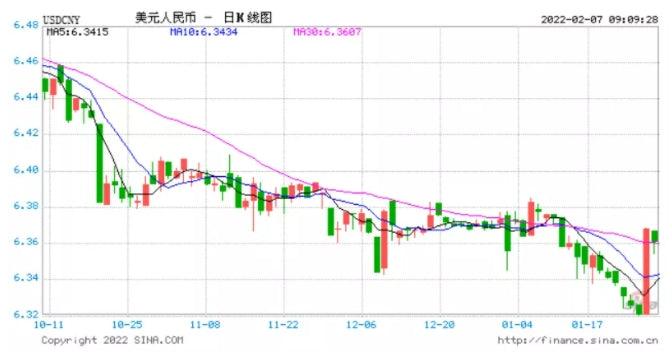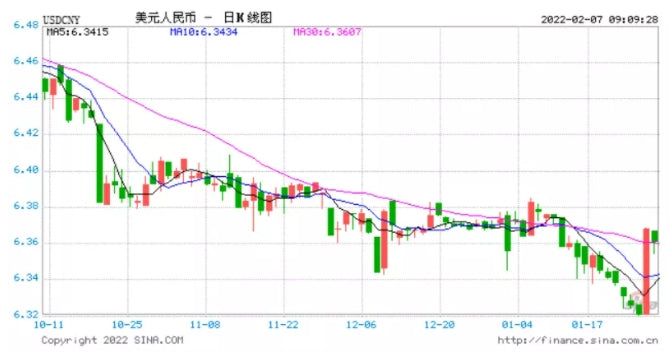2022 RMB Exchange Rate: Future Trends

The renminbi continued its strong bilateral exchange rate against the US dollar at the start of the New Year, with both the central parity rate and the trading rate hitting a 45-month high of 6.33. Since January 27, there has been a correction. On January 28, the central parity rate of RMB closed at 6.3746, basically unchanged from the end of the previous year. It is expected that the RMB exchange rate will continue to strengthen but the momentum will weaken.
The RMB exchange rate continued to strengthen
Since September 2021, in order to avoid the influence caused by the concentrated settlement of foreign exchange at the end of the year, domestic enterprises have adopted the operation of increasing the settlement of foreign exchange or paying with their own foreign exchange. From September to December 2021, the total trade surplus of customs increased by 31 percent year-on-year, while the total foreign exchange surplus of banks decreased by 22 percent.
Among them, the surplus of foreign exchange settlement and sales in December 2021 was US $43.5 billion, down 56% year on year, accounting for only 16% of the annual surplus. This is the important market logic that caused the dollar index (95.5058, 0.0374, 0.04%) to set a new high, the dollar was stronger, the RMB was stronger, and the RMB exchange rate was decoupled from its trend. From the beginning of September to the end of December last year, there was a strong negative correlation between the DOLLAR index and the RMB midpoint, which lagged one trading day, and the correlation coefficient reached 0.758.
In the New Year, RMB exchange rate and DOLLAR index recovered the seesaw effect.
In January, the correlation between them turned positive after taking the natural logarithm, and the correlation coefficient was 0.216. From January 4 to 19, there was a strong positive correlation between them, with a correlation coefficient of 0.796. The positive correlation decreased from January 20 to 28, but the correlation coefficient still reached 0.606. This shows that in the first and middle of January, the USD index fell below 96 and 95 successively in the international market, which was the main reason driving the RMB exchange rate higher, and the USD index broke through 97 strongly at the end of the month, which triggered the RMB exchange rate correction.
The continued strength of the RMB exchange rate also reflects the role of market supply and demand.
In January, the central parity of RMB exchange rate rose and fell along with the DOLLAR index in the international market. As the US dollar index fell first and then rose, and the RMB exchange rate rose first and then fell, the central parity rate of the RMB exchange rate rose by 11 basis points during the whole month. In 14 of the 19 trading days that month, the close was stronger than the daily midpoint, contributing 335 basis points to the appreciation of the midpoint.
From the perspective of the difference between the trading prices of RMB exchange rates at home and abroad, the offshore RMB exchange rate (CNH) continued to depreciate relative to the onshore RMB exchange rate (CNY). From the beginning of the year to January 28, the average daily difference was 70 basis points, an increase of 18 basis points compared with the average daily difference last month. This suggests that the current appreciation is still largely onshore market driven.
Appreciation momentum may be reduced
The current momentum of RMB exchange rate appreciation may be weakened. On the one hand, the domestic interbank market foreign exchange volume decreased. In January, the average daily foreign exchange volume of spot inquiry in the interbank market was USD 30.8 billion, down 8% month-on-month and 15% year-on-year, and the average daily volume was the lowest for the same period since 2019. In particular, during the four consecutive trading days from January 21 to 26, when the RMB central parity rate and trading price broke 6.34 and 6.33 again and again, setting new highs, the daily foreign exchange trading volume was below 29 billion US dollars and the average daily trading volume was 26.7 billion US dollars, 14% lower than the average daily trading volume from January 4 to 20.
On January 27, due to the sharp rebound of the DOLLAR index, the intra-market trading price of RMB exchange rate quickly reversed. On that day, the domestic foreign exchange turnover reached 46.8 billion US dollars, up 78% from the previous month, and the scale hit a new high in the past three months. From the high-frequency daily trading data, this shows that after the annual effect period of financial accounting and strong demand for RMB payment, the domestic foreign exchange supply and demand tend to improve on the whole, and it also indicates that the exchange rate leverage of "low (appreciation) buy high (depreciation) sell" is in normal play.
On the other hand, the RMB bilateral and multilateral exchange rate increases tend to moderate. In 2021, due to bank settlement and sales of foreign exchange of nearly 100 billion yuan at the end of the previous year, the RMB exchange rate rose to more than 6.50 at the beginning of the year. In the first month, the US dollar index fell by 0.6% at most, and the RMB exchange rate index of China Foreign Exchange Trade System (CFETS) rose by 1.7%.
In January this year, the import and export surplus of customs was nearly 100 billion yuan last month, but the RMB exchange rate did not exceed 6.30. In the case of the largest decline of 1.1% in the DOLLAR index, the maximum increase of the bilateral and multilateral RMB exchange rates was not more than 1.0%.
Market factors are expected to cause exchange rate correction
In November last year, the eighth working meeting of the self-regulatory mechanism of the National foreign exchange market reiterated that "two-way volatility is normal and reasonable balance is the goal", and proposed for the first time that "the degree of deviation is proportional to the power of correction". Earlier this year, the CENTRAL bank pointed out that the exchange rate may deviate from its equilibrium level in the short term, but in the medium to long term, market and policy factors will correct the deviation.
As mentioned above, both year-on-year and quarter-on-quarter, the momentum of RMB exchange rate appreciation has weakened. After "one rise after another", rather than continue to predict whether the RMB exchange rate will break 60, it is better to pay attention to the exchange rate correction that may be triggered by market or policy factors.
One is the risk of further dollar index strength. Since the beginning of this year, the Federal Reserve has not only changed its "temporary" statement on inflation and indicated that it would accelerate the pace of reducing bond purchases, but also put out the wind at the meeting at the beginning of the year. It does not rule out the possibility of raising interest rates at every meeting in the future, and will even consider shrinking the balance sheet this year, or promote the dollar index to further rebound.
Second, the risk of further narrowing of china-us interest rate differentials. Last year, due to the re-misalignment of Chinese and US monetary policies, the yield of 10-year Chinese and US Treasury bonds shrank by nearly 100 basis points. The net increase of domestic RMB bonds held by foreign institutions in the whole year still reached 748.7 billion yuan, but decreased by 30% year on year. Since the end of last year, the People's Bank of China has cut interest rates and reserve requirement ratio to stabilize growth, while the Federal Reserve has accelerated the exit of monetary policy to control inflation. As the divergence of Monetary policies between China and the US increases, interest rate differentials between China and the US are expected to further narrow. In January, the 10-year Treasury yield spread narrowed by more than 30 basis points in a single month to just around 90 basis points.
Third, the risk of worsening international financial turmoil. Since 2020, global risk asset prices represented by the US stock market have surged, benefiting from super monetary easing by major central banks, especially the Federal Reserve. So far this year, the A-share market has been largely linked to overseas market turmoil. Given the persistence of high domestic inflation, the Fed has acknowledged that monetary policy is lagging behind, which could allow the correction in risky asset prices caused by less than expected monetary easing to materialise.
Fourth, the risk of convergence between China and the US. In its latest World Economic Outlook, the INTERNATIONAL Monetary Fund (IMF) pointed out that the global economy will continue to recover but the recovery momentum will weaken this year, and the annual growth is expected to be 4.4 percent, 1.5 percentage points lower than last year. Among them, the difference in economic growth rate between China and the US is expected to be low.
The fifth is the policy risk of exchange rate expectation management and regulation. Since the shock appreciation of the RMB exchange rate in early June 2020, relevant departments have made many statements and introduced policies to guide market expectations. At present, the appreciation of both bilateral and multilateral RMB exchange rates has continued for a period of time and accumulated a certain increase, which is an important reason for foreign trade enterprises to "dare not accept orders" and "increase revenues but not profits". There is a risk of overshoot of RMB exchange rate deviating from economic fundamentals in the short term. It is expected that while strengthening public opinion guidance, relevant authorities will continue to take policy measures to increase exchange rate flexibility, expand capital outflow and regulate capital inflow if necessary, so as to keep the exchange rate basically stable at an appropriate and balanced level.
Risk, it should be noted, is uncertainty. The five "risks" mentioned above are not certain to occur in the future, but if they do, they will have the opposite effect on the renminbi's exchange rate. Exchange rate uncertainty is inevitable, two-way fluctuation is normal. There is no currency that is all up and all down. Market subjects should deeply understand and understand the neutral connotation of exchange rate risk, adhere to the "preservation" rather than "appreciation" as the core control and management of exchange rate risk, so as to increase the odds of victory in the internal and external uncertainty and instability.
WE RECOMMEND
Related posts
- Subscribe MedInsights
- Subscribe MedInsights
- Subscribe MedInsights
- Subscribe MedInsights
- Subscribe MedInsights











